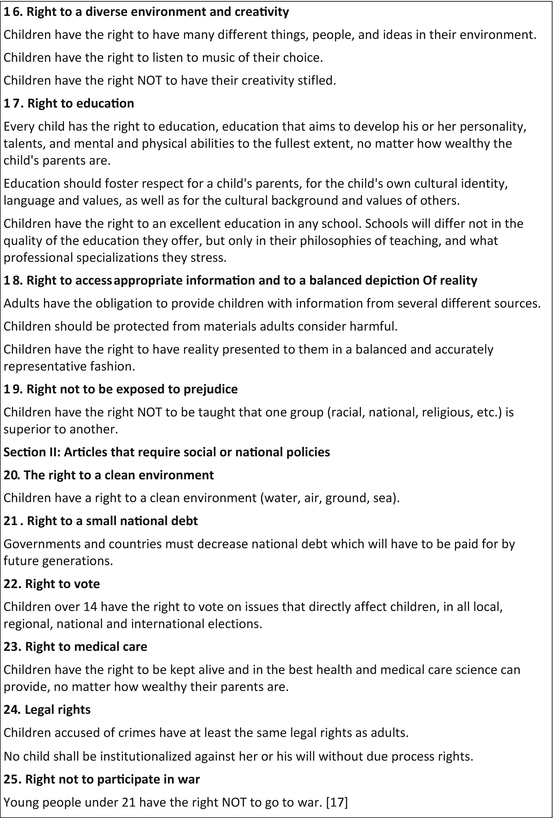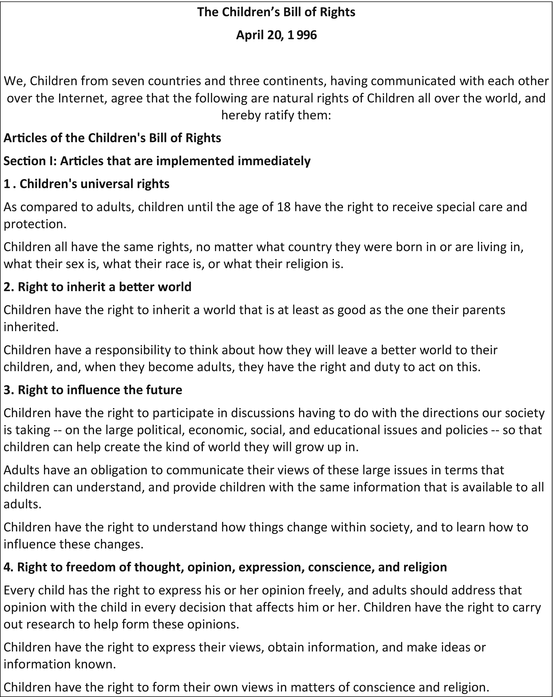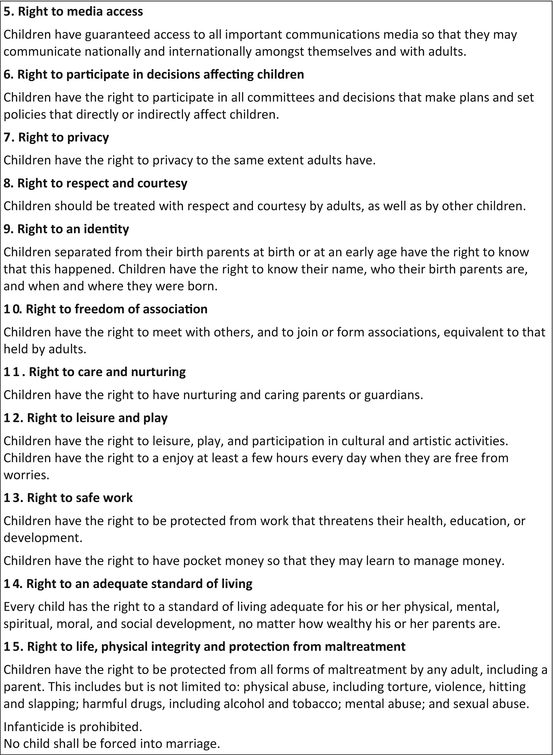Neglect: Should There Be Mandatory Reporting?

Basic data
Child population of 52 jurisdictions
74,577,627
Child population of 51 reporting jurisdictions
74,150,798
Reported unique children who
3,165,572
Received a CPS response
Unique victims from reporting
678,810
Type of abuse
Medical neglect
15,705
Neglect
531,241 (78.3 %)
Physical abuse
124,544 (18.3 %)
Psychological maltreatment
57,880 (10.6 %)
Sexual abuse
62,936 (9.3 %)
Perpetrator
Mother
250,553
Father
127,654
Mother and father
132,557
Other (combinations)
46,894
Total parents
557,658 (81.5 %)
Total nonparent
81,816 (12.0 %)
Total unknown
44,774 (6.5 %)
Fatalities
Child population of reporting states
72,483,465
Fatalities
1,593
These data confirm that neglect is the most common manifestation of child maltreatment identified and reported. This then leads us to return to the question of whether neglect should be reported using the usual models of reporting which tend to be categorical and adversarial. If the answer is “yes,” then should the reporting mechanism continue with the current process? If the answer is “no,” then should the reporting be different and the response different and what should be done to address the needs of the population of children who are neglected and not reported? What mechanisms are in place to protect them and thereby safeguard and preserve their rights as citizens of the country?
From the pediatric and epidemiological perspectives, the term neglect is an umbrella for various acts of omission and even commission, and this is codified in law to some extent at least in the State of Colorado. Thus, the encompassing pediatric definitions of child neglect easily include deprivation of necessities; the presence of an injurious environment or environmental neglect; medical, educational, and emotional neglect; the failure to protect a child; and a lack of supervision or supervision inconsistent with the child’s needs or capabilities. The importance of neglect is demonstrated in a recent article in which Welch and Bonner (2013) reviewed child fatalities in Oklahoma spanning the years 1987–2008. During that period, they identified 372 deaths associated with neglect among children ranging from 0 to 17 years. The categories of death identified included supervisory/environmental neglect, deprivation of needs, and medical care neglect. Deaths associated with neglect occurred most commonly among boys (58.1 %), with 58.7 % of all of the deaths occurring among children ≤2 years of age. Women, in 80.4 % of the deaths, were the responsible party and in 71.2 % of the deaths it was the mother. The primary cause was supervisory/environmental neglect rather than deprivation of needs or medical neglect. The most common events associated with these deaths were unintentional drowning (23.9 %) and smoke inhalation (13.4 %). Of interest, 12.4 % of the children in the study had current involvement with Child Protective Services, and 41.9 % had had contact with another section or division in the Department of Human Services.
What can be learned from this study? It is currently the largest data set of child mortality associated only with neglect. Infants and young children require close supervision. This is driven home by deaths of children left at home without smoke detectors and those left unsupervised who drowned. Given that neglect can be fatal, and in many cases might be prevented, should neglect be regarded as a “less important” manifestation of child maltreatment? This translates to a policy in which children will be recognized as neglected, but not reported. Why not determine with greater reliability and validity if the most severe risk for neglect and nonfatal neglect can be identified so that death may indeed be avoided and further neglect be prevented?
How to Improve Policy and Practice: There Is Usually More than One Possible Approach
In the current framework, many assume that the result of the “systems” in play is that someone is culpable or responsible for the neglect. The newer model first subscribes to the view that neglect of a child’s needs should be identified and shown as not being addressed for whatever reasons. Second, this model recognizes that there are multiple factors contributing to neglect while acknowledging parents and/or other caregivers often play a significant role (Dubowitz et al. 2005). In Dubowitz’s model, the goal is not only in identifying neglect and making the appropriate authorities aware of its presence but working to avoid unnecessarily imputing blame. The proper focus should be to understand the causes of the neglect and to correct them. If we can understand the causes and conditions associated with neglect, which will be framed in terms of the child’s needs not being met, then perhaps methods can be designed and supported to prevent or ameliorate the effects of neglect. This change of emphasis must recognize both the core elements and variations among current definitions while working to address how the concept of neglect is framed. The local conditions in which children are raised do vary from country to country, community to community, and from one socioeconomic class to another. The response to neglect will reflect the way a society or community perceives the child as an individual, not merely an appendage of others even in the midst of family, and the child’s rights as being separate and unique from those of the parents or caregivers.
Dubowitz and his colleagues (2005) identify 12 types of basic needs which, if not addressed, constitute neglect. They include inadequate food, exposure to household hazards, inadequate personal hygiene, inadequate health care, inadequate mental health, inadequate emotional support and/or affection, inadequate parental structure and/or guidance, inadequate cognitive/stimulation/opportunity, unstable caregiver relationship, unstable living situation, exposure to family conflict and/or violence, and exposure to community violence and/or lack of neighborhood safety. These types of neglect can be used in an attempt to conceptualize neglect not as specific categories but from an ecological perspective, recognizing there are multiple and interacting factors that contribute to neglect and perhaps define it. One of the fundamental aspects of neglect that came out of this study was the concept of neglect as a continuum based on a variety of measures and reports from multiple sources including the parent and child.
Culture that Emphasizes the Rights of Children as Individuals Even While Living in Families
Embedded in the above framing of neglect is actually a list of children’s rights. It is noteworthy that in the beginning of the twentieth century, before the Geneva Convention or the United Nations addressed the need for a declaration of children’s rights, Janusz Korczak, a Polish pediatrician, spoke of the need for such a document. Korczak died in 1944 in Treblinka, one of the death camps in Poland. Before his death, he started to identify what those rights were. A partial list of these rights includes the child has a right to love, the child has a right to respect, the child has a right to optimal conditions in which to grow and develop, and the child has a right to an education (Lifton 1988). It is noteworthy that some 50 to 60 years later these values are again expressed, in more depth in the World Health endorsement of the Children’s Bill of Rights.






A review of the above statement by children from seven countries makes apparent that the rights articulated by Korczak, the World Health Organization, the United Nations Convention on the Rights of the Child, and the 12 needs identified by Dubowitz et al. have much in common. They all lead to the awareness that if children are denied basic rights to have their needs met, then by definition, they are being neglected. This is of course easy to say on paper, but how does it play out in the multiple countries and communities in the real world? Does it apply to all socioeconomic, racial, and religious groups? If one considers the literature on neglect, there is a common implication that neglect occurs primarily (and perhaps only) among the poor. There are data demonstrating that neglect occurs more commonly among the poor (Slacks et al. 2004). However, neglect does also occurs among the more advantaged in our communities, including failures to provide loving care and attention that are probably never reported. Why shouldn’t emotionally unavailable parents, a lack of committed nurturing, and withdrawal of support constitute forms of neglect? How should the plight of “latchkey” children be characterized?
What of children who come home every day from school to empty if affluent homes with perhaps only a pre-prepared meal waiting to be warmed in the microwave? Can this also be considered a failure to meet the child’s needs? These children might have their physical needs met, but what about their emotional and developmental needs? This behavior appears to be emotional neglect, as defined above.
Cultural and Policy Tradeoffs
The consequences of neglect and the consequences of not reporting neglect should be considered together. How serious are the effects of neglect versus the prevalence of harm to families due to intervention attempting to identify and help treat neglect? How much of the research now available on neglect has resulted from studies of children who were identified through reports of neglect, and how many resources flow to addressing neglect due to annual reports of the incidence and prevalence of neglect? There is much more research on the costs to children’s health and well-being from neglect than research on the downsides from reporting, evaluation, and treatment, both when provided and not provided after a report.
An important place to begin the analysis on the importance of neglect for identified victims is to consider the impact of neglect on infants (Wotherspoon and Gough 2008). Infants from their birth learn affect regulation and are dependent on caretakers to help them modulate their responses to stress. The needs of the infant include a nurturing, responsive, consistent, and available caretaker, for as much time as possible. If caretakers are inconsistent, intrusive, or violent in their responses to the infant, or “merely” unavailable, the stress to the infant can be almost intolerable. Neglect at this age, aside from physical neglect (including under nutrition which can lead to death), is known to have adverse social, emotional, and intellectual consequences. Neglect occurs when the caretaker cannot or does not read the infant’s cues and so is unable or unwilling to respond appropriately and contingently. Signs in infants having these experiences include inconsolable crying, passivity or listlessness, altered sleep patterns, feeding disorders – often associated with problems with digestion – and an absence or very limited repertoire of self-soothing behaviors. Among the consequences of emotional neglect are cognitive delays and poor academic functioning, social withdrawal, and poor peer interactions along with a greater incidence of internalizing problems such as depression and anxiety (Wotherspoon and Gough 2008). The early work on hospitalism by Rene Spitz (1946) and the later work by John Bowlby (1988) on the importance of attachment for normal instead of abnormal infant development both demonstrate that at least minimally competent, loving care that includes the characteristics just described is essential for good child development and can be the difference between life and death.
The effects of neglect extend beyond infancy, producing long-term consequences (Goldson and Bonner 2008). With or without experiences of neglect during infancy, older children can experience many forms of neglect including (1) a lack of adequate food and nourishment; (2) failure to support school attendance, achievement, and activities or allowing or encouraging truancy; (3) leaving children unattended, not providing adequate supervision, or failing to protect children from maltreatment or dangerous situations; (4) failure to provide safe housing or appropriate clothing; (5) failure to meet a child’s needs for nurturance and interaction (see psychological maltreatment below); and (6) failure to adhere to medical or therapeutic procedures recommended for serious diseases, injuries, or emotional and behavior problems (Erickson and Egeland 2002). The experience of child neglect at different stages of development creates the risk of cumulative injury to development.
In many cases, infants and children suffer from several forms of neglect, concurrently, increasing the risk of serious consequences on the child’s development and behavior. Although physical and sexual abuse currently receive more public and professional attention, the majority of substantiated cases of maltreatment in the USA are for a form of neglect or multiple forms of neglect (Welch and Bonner 2013).
Neglect can be chronic, such as long-standing lack of adequate nutrition or episodes of leaving children unattended for periods of time. This is an example that reflects the Dubowitz model which speaks to a failure of meeting the needs of the child. For example, data reveal children are most likely to die in child-set fires that occur when appropriate adult supervision is lacking (Bonner et al. 1999). Other forms of fatal neglect occur when caregivers fail to provide necessary medical care (Geffken et al. 1992) or fail to meet the nutritional and emotional needs of the child, resulting in failure to thrive (Oates and Kempe 1997).
Over the long term, the main focus in research on neglected children has been on physical and emotional neglect. In one of the first studies to specifically study neglected children, they were found to have learning problems, low self-esteem, and as they grew older, a high rate of delinquency (Steele 1977). Subsequent research showed that neglected children were less interactive with their peers (Hoffman-Plotkin and Twentyman 1984), were passive, tended toward helplessness in stressful situations, and evidenced significant developmental delays (Crittenden and Ainsworth 1989). They had severe language delays and disorders (Katz 1992) and experienced a significant decline in school performance upon entering junior high school (Kendall-Tackett et al. 1993). Longitudinal studies have shown the negative effects of physical neglect, particularly during preschool and primary grades for the children’s school behavior (Erickson and Egeland 2002). These problems related to physical neglect continued into adolescence, with these youth having low school achievement scores, heavy alcohol use, and school expulsions and dropouts. Clearly, physical neglect can have devastating effects on children’s and adolescents’ functioning and adjustment.
In the past decade, studies have focused on the neurobiological consequences of maltreatment and suggest that maltreatment leads to compromised central nervous system and brain development (Perry 1997). Studies have documented impairments in physiological functioning (Lewis 1992) characterized by smaller intracranial and cerebral volumes in maltreated children with PTSD versus controls (DeBellis et al. 1999a, b). Perry (2002) discussed the severe, long-term consequences for brain function if a child’s needs for stable emotional attachments, physical touch from primary adult caregivers, and interactions with peers are not met. He suggests that if the necessary neuronal connections are lacking, the brain development for both caring behavior and cognitive capacities is damaged in a “lasting fashion.”
The current research reveals neglect is a major social problem affecting thousands of children across the USA. Those neglected children who survive have problems developing adequate confidence, concentration, and social skills necessary to successfully adapt to school and to develop and sustain interpersonal relationships (Erickson and Egeland 2002). Without appropriate intervention in the family and with the child, the prognosis for these children is guarded.
Expanding the discussion slightly, the effects of psychological maltreatment are often difficult to separate from those of other types of maltreatment, as children are often victims of multiple forms of abuse. Psychological maltreatment is considered by many professionals to be a core component of all forms of child abuse and neglect (Binggeli et al. 2001; Claussen and Crittenden 1991; Brassard et al. 1987). Findings from longitudinal, prospective research, cross-cultural research, and studies designed to compare the impact of different forms of abuse have served to support this concept and document the severe outcomes associated with chronic child neglect.
The Minnesota Parent-Child Project followed a cohort of children from birth to adulthood whose mothers were at risk for parenting problems (Egeland 1997; Egeland and Erickson 1987; Erikson et al. 1989). When compared with children from the control group, the maltreated children, including those who were psychologically maltreated, showed serious consequences. Children whose mothers were hostile or verbally abusive demonstrated anxious attachments, lack of impulse control, distractibility, hyperactivity, angry and noncompliant behavior, difficulty in learning and problem-solving, negative emotions, and lack of persistence and enthusiasm. However, the effects of a psychologically unavailable mother, i.e., one who denied emotional responsiveness to the child, was the most devastating. The outcomes for the children with psychologically unavailable caregivers included a decline in competency from infancy through the preschool years, anxious avoidant attachment, noncompliance, lack of impulse control, low self-esteem, high dependence, self-abusive behavior, and serious psychopathology. Other longitudinal studies have shown that parental rejection and lack of positive parent-child interactions are significant predictors of childhood aggression and delinquency (Lefkowitz et al. 1977; Loeber and Stouthammer-Loeber 1986).
Psychological maltreatment includes both acts of commission, i.e., parental hostility and verbal aggression, and acts of omission, i.e., parental neglect and indifference and denying emotional responsiveness to a child’s cues. A multi-method study of dozens of anthropology studies found that parental rejection had negative effects on children in every culture and existed in many of the world’s cultures (Rohner and Rohner 1980). Children who were rejected tended to be aggressive, have poor self-esteem, be emotionally unstable and unresponsive, and have a negative worldview.